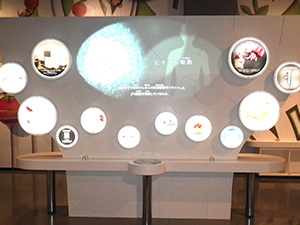Nagoya City Science Museum
TOP > Exhibition Guide > Floor Map> Fruits of Biotechnology
Fruits of Biotechnology



Purpose of Exhibition
Since far in the past, we humans have used the living beings around us for food, clothing, and medicine. For example, our ancestors started to find, collect and eat wild plants. Afterward, we wanted to make it easier to raise them, to harvest them frequently and, to make them more delicious. So, we continue making a more desirable cultivar. This is biotechnology, the wisdom of humans for using organisms. Based on such traditional technology, there began in the latter half of the 20th century a new age of biotechnology applying the elucidated mechanisms and functions of cells and genes. This new technology has spread its roots not only into basic biology, chemistry, engineering, agricultural science, medicine and pharmacy, but also into information science too.
On the other hand, in the application of technology, the benefits (profits) and the risks (possibility of danger) are inseparable. Applications of technology have various aspects, both social and economic aspects as well as environmental problem aspects. Another aim is to become a trigger for thinking and discussing with each other more deeply about how to face this.
* The word "biotechnology" was formed by combining "biology" and "technology". It is sometimes shortened to simply "bio".
Additional Knowledge
The "Fruits of Biotechnology" exhibits introduce products already in practical use or in the research stage, dividing biotechnology into "medicine", "food", and "the environment & energy".
[Medicine]
This section covers medical treatment, genetic diagnosis, and pharmaceuticals utilizing genetic engineering and cell engineering. Among these, "regenerative medicine" is drawing particular attention as an advanced medical treatment. What regenerative medicine is aiming for is the ability to restore organs that have ceased functioning due to illness or age using your own cells, in the same way that if the tail of a lizard is cut off, it grows back (regenerates). Therefore, much research is being carried out into embryonic stem cells (ES cells) and induced pluripotent stem cells (iPS cells).
[Food]
This section introduces technology using genetically modified crops, breeding of DNA markers using genetic analysis, plant variety evaluation, and microbic fermentation.
The first genetically modified crop was the "Flavor Saver" tomato, which went on sale in the U.S. in 1994. After that, soybeans that are not affected by herbicides, corn that resists harmful insects, etc. were developed with genetic modification technology. Now, their field is spreading around the world. In Japan, 8 crops (298 varieties) and 8 types of food additives (18 items) have been approved (as of January 5, 2015). Now the fields for such crops are hardly found in Japan at all, but are imported from overseas and processed into animal feed, starch, oil, etc. and support the diets of the Japanese people.
[Environment & Energy]
How to reduce emissions of global warming gasses? How to deal with the exhaustion of petroleum and rare earth metal resources? How to clean up polluted environments? Biotechnology is active in working on these environmental problems too. Development of technology using particularly small organisms, E. coli, and other bacteria and mold, and photosynthetic algae, is thriving. For example, algae have been discovered that produce fertilizer and bio-ethanol fuel from factory emission gases and water using photosynthesis. On the other hand, there are also microbes that eat petroleum and techniques are being developed for cleaning up soil polluted by petroleum, for example at the ruins of gas stations.
Thus, much is expected of biotechnology in many fields. We want to heal illness and /or to help people suffering from starvation. We want to reduce environmental problems, even if just a bit. What roles will biotechnology play between risks and benefits for our lives? What kind of a future will we aim for with biotechnology?
Article by Chieko Ozaka, curator
